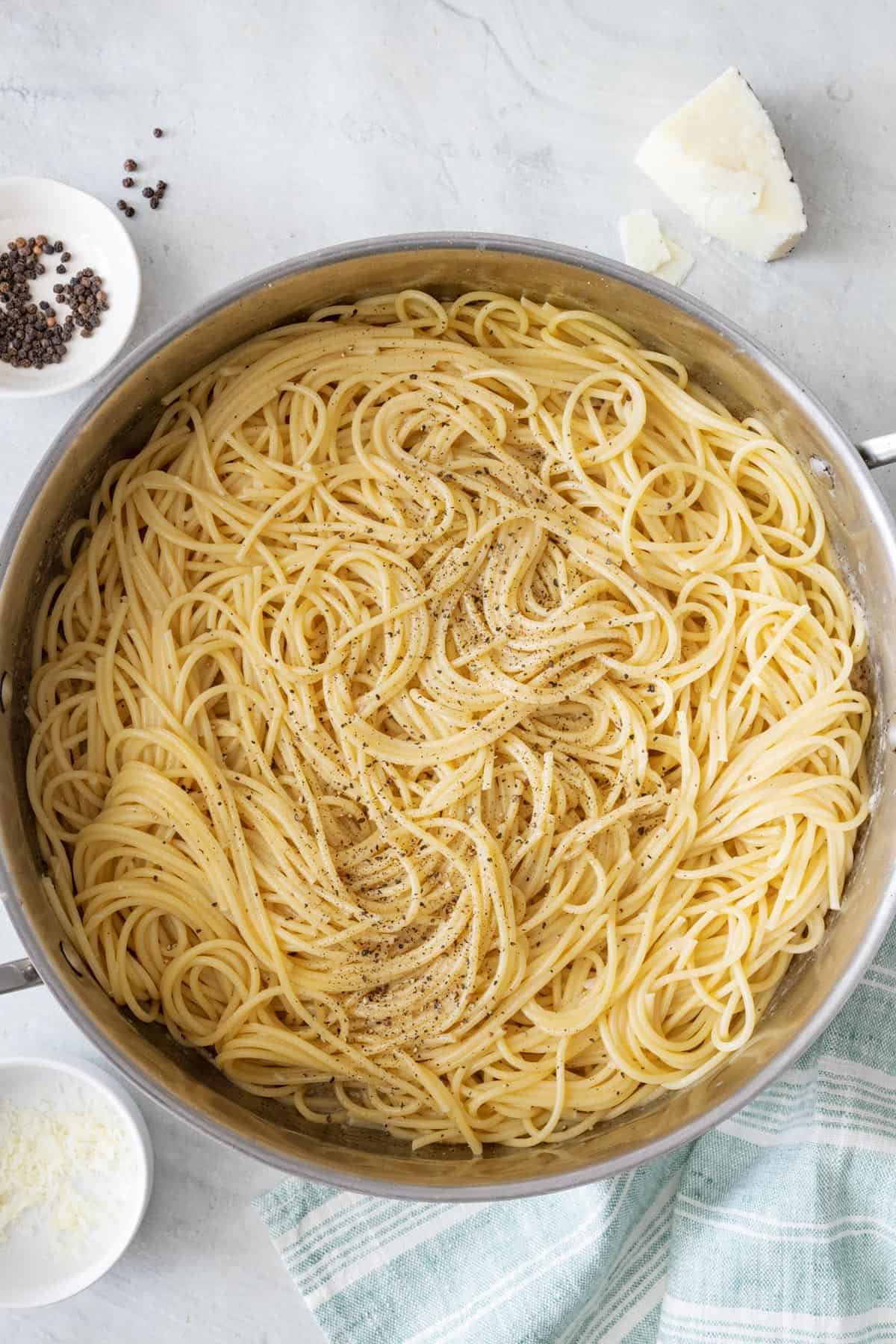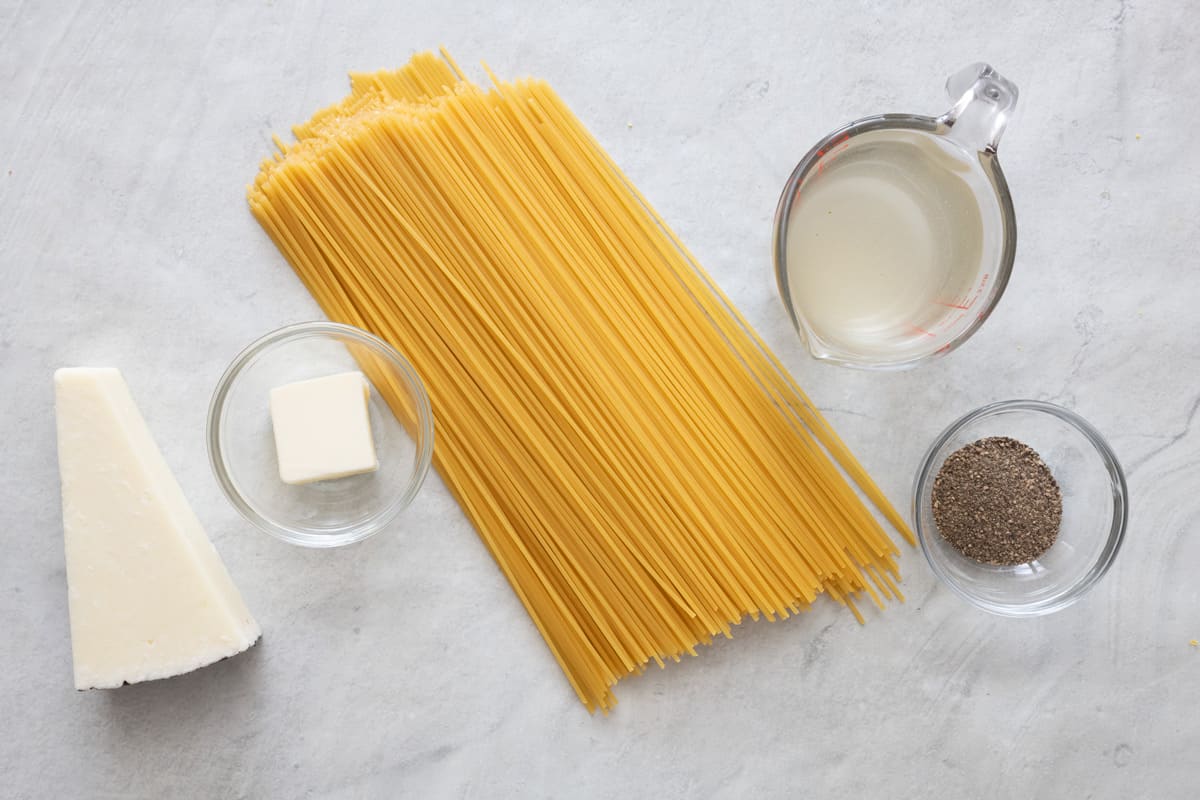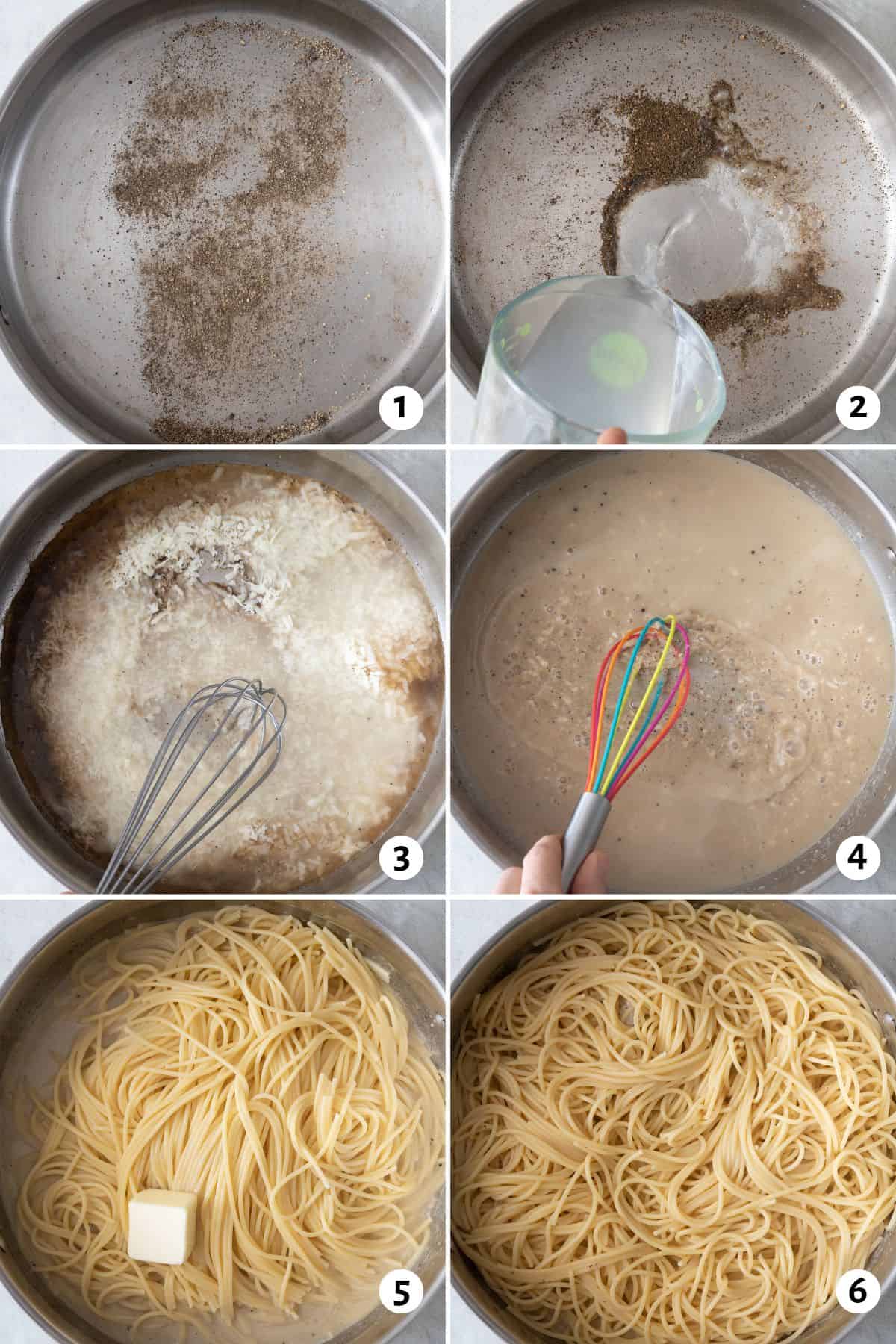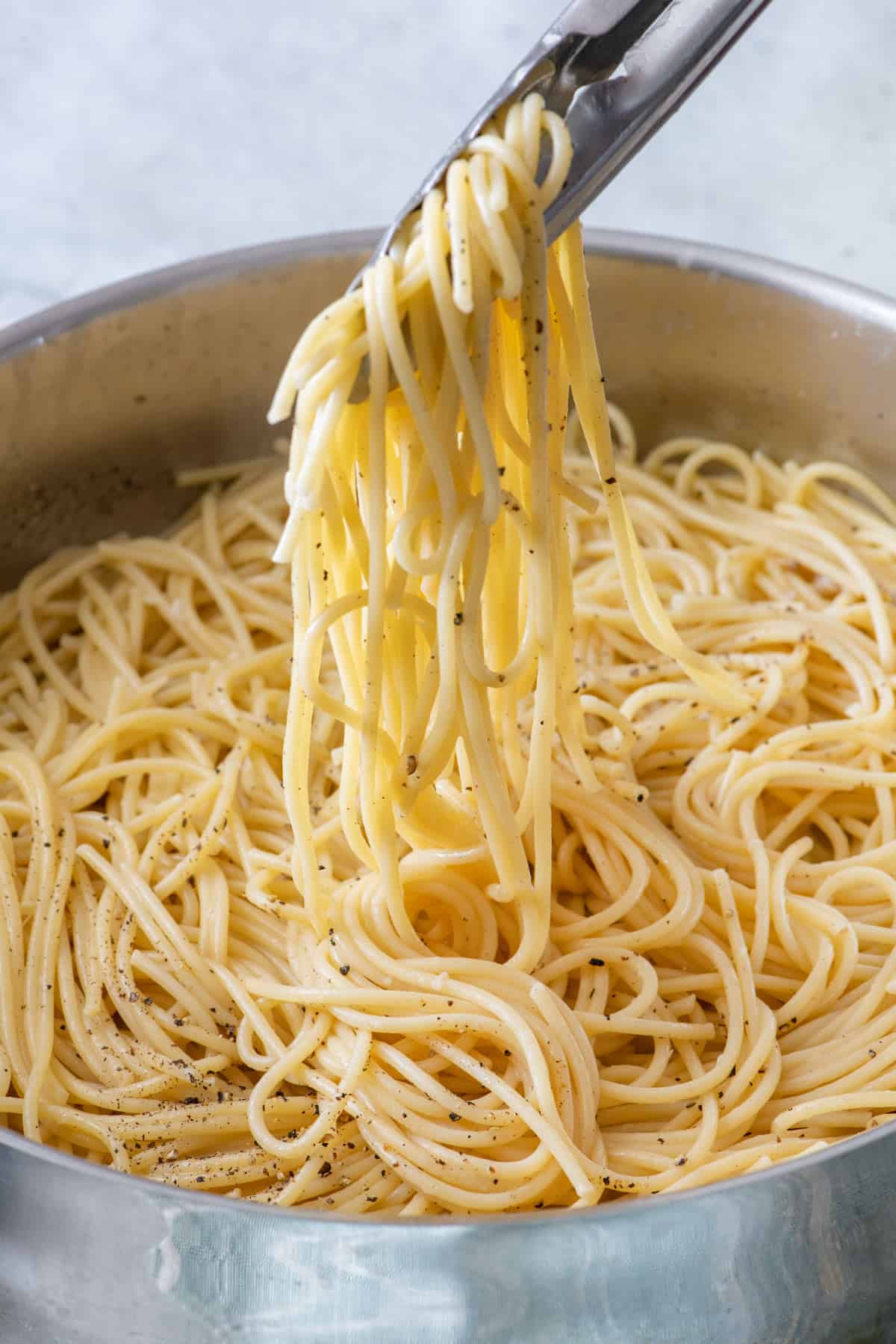Cacio e Pepe
Published Feb 12, 2024
Cacio e Pepe is an irresistible pasta dish combining the sharpness of Pecorino Romano cheese with the heat of fresh cracked black pepper, ready in 20 minutes
This post may contain affiliate links. Please read our disclosure policy.
One of my favorite dishes to order at Italian restaurants is cacio e pepe. It always amazes me that the recipe is traditionally made with only pasta, black pepper, and cheese—that’s it! This is my interpretation of the recipe with easy-to-follow instructions for how to replicate this simple classic Italian recipe for your family in under 20 minutes.

Jump to Section
Cacio e pepe translates to “cheese and pepper,” so you’ll notice those are the prominent flavors that really make this pasta dish stand out. The sharp spice from black pepper and creamy tanginess from Pecorino Romano really are a match made in heaven. My cacio e pepe recipe adds butter as well to give the sauce a smooth, glossy texture, that can be hard to do otherwise with just pasta water and cheese.
Recipe At a Glance
Cuisine Inspiration: Italian
Primary Cooking Method: Stovetop
Dietary Info: Vegetarian
Key Flavor: Cheesy and Peppery
Skill Level: Easy
Summary
- Simple Ingredients: This straightforward recipe uses only 4 ingredients (and I’m willing to bet you have most in your kitchen already).
- Quick and Easy: Only 20 minutes start to finish, this cacio e pepe recipe is perfect to whip up on a busy weeknight.
- Cheesy and Peppery: With creamy Pecorino Romano and a dash of heat from the black pepper, this feels like elevated comfort food.
- Family Friendly: Cacio e pepe makes a great meal for adults and kids alike. Simply use less pepper while cooking for the kiddos. You can always top your pepe pasta with freshly ground pepper before eating.
Ingredients to Make Cacio e Pepe

- Spaghetti: A thick, long pasta like spaghetti is best for swirling up the creamy cacio e pepe sauce. Be sure to save the starchy pasta water to help the cheese melt evenly and bind to the pasta.
- Freshly Ground Black Pepper: I find that grinding fresh black pepper (rather than using pre-ground) really amplifies the aromatic peppery flavor.
- Pecorino Romano: I recommend finely grating the cheese yourself really helps to create a smooth, silky sauce. Skip the grated or shredded cheese to avoid clumping.
- Butter: Technically, butter is not one of the core ingredients for making an authentic cacio e pepe, but I think it makes the sauce more glossy and rich. You’ll only need 2 tablespoons.
Popular Substitutions & Additions
- Opt for Parmesan: You can use Parmesan instead of Pecorino Romano, or even combine the two for a unique cheese profile. However, Parmesan isn’t as salty or tangy as Pecorino Romano, so you may need to add more to get the sharpness that cacio e pepe is known for.
- Swap Out the Spaghetti: Instead of spaghetti, you can try another thick, long pasta (like fettuccine or bucatini) or any pasta shape you have on hand.
- Make It Gluten Free: Cacio e pepe can easily be made gluten free; simply use a gluten-free pasta instead of regular spaghetti.
- Use Pink Peppercorn: If you’re feeling fancy, you can try swapping in pink peppercorns to create a unique flavor.
- Add a Protein or Veggie: Cacio e pepe pasta pairs well with a number of possible mix-ins, such as grilled chicken or lemon garlic shrimp, steamed broccoli or asparagus.
How to Make Cacio e Pepe
- While you cook the pasta, toast the black pepper in a large skillet until you can smell it.
- Add pasta cooking water on top of the pepper and bring to a simmer.
- Add the finely grated Pecorino Romano cheese and more pasta water.
- Whisk until it comes together into a creamy, glossy sauce.
- Add the cooked spaghetti and butter.
- Toss until well combined and you notice that the sauce clinging to the pasta.

Tips for Making the Best Cacio e Pepe Sauce
- Grind pepper finely. If the pepper is too coarse, it can add unwanted bursts of spice and affect the dish’s balance.
- Prep your cheese ahead of time. Aged hard cheeses like Pecorino Romano take longer to melt. Grate it as finely as possible with your smallest hole size (ideally, an ultra-fine microplane) and let it sit before you start cooking. This helps it melt more quickly and combine evenly in your sauce.
- Reserve pasta water before draining the pasta. The starch in pasta water is essential—it helps the cacio e pepe sauce bind to the pasta and emulsify to create a creamy texture.
- Turn down the heat and gradually whisk in your cheese. Add the cheese little by little at a lower temperature while continuously whisking to ensure a consistent melt throughout the sauce. Take your time, this step may take up to five minutes or more.
What To Serve With Cacio e Pepe Pasta
- Lemon Pepper Seared Salmon
- Easy Broccoli Recipe
- Parm-Crusted Brussels
- Lemon Garlic Shrimp
- Garlic Steak Bites

How To Store & Reheat Cacio e Pepe
Cacio e pepe can be stored in an airtight container in the refrigerator and reheats well as long as your pasta is cooked al dente (though, the results likely won’t be as creamy as the when it was first served).
To reheat, simply add a splash of water to help thin and refresh the sauce. Reheat in the microwave, or on the stovetop over low heat.
How long will cacio e pepe last in the fridge?
Like most vegetarian pasta recipes, this will last up to 5 days in the fridge when stored in an airtight container.
Can I freeze this cacio e pepe recipe?
I don’t recommend freezing cacio e pepe. The cheese can become clumpy during the thawing process and affect the texture of the sauce.
Frequently Asked Questions
Traditionally, Romans use a square-shaped spaghetti called tonarelli, but spaghetti and bucatini are also common. A long, thick pasta has the best texture and surface area for the cheese sauce to cling to.
When making cacio e pepe, cheese can clump for two reasons: high heat and the lack of an emulsifier. Reduce the heat of your pan after toasting the pepper. Before adding in Pecorino Romano, mix in pasta water which serves as our emulsifier here. The starch in the pasta water creates a barrier that prevents the fats in the cheese from separating into clumps.
First, use pasta water, not regular water because it helps the fats and liquid combine smoothly. Second, add in the cheese gradually, whisking throughout until it reaches a smooth texture. Finally, add in butter for a truly rich and creamy sauce.

If you’re looking for a simple-yet-soulful Italian pasta recipe, cacio e pepe is for you! This flavorful dish is rich and cheesy enough to feel luxurious, yet quick and easy enough to earn a regular spot in your weeknight recipe rotation. My family loves it, and I think yours will too!
More Pasta Recipes:
- Roasted Red Pepper Pasta
- Hummus Pasta
- Creamy Tomato Pasta
- Pumpkin Pasta
- Cauliflower Alfredo
- Pasta with Cherry Tomatoes
- One Pan Pasta
- Lemon Pasta
- Roasted Cherry Tomato Pasta
- Creamy Cashew Tomato Pasta
If you try this feel good Cacio e Pepe recipe or any other recipe on Feel Good Foodie, then don’t forget to rate the recipe and leave a comment below! It helps others who are thinking of making the recipe. We would love to hear about your experience making it. And if you snapped some shots, share them on Instagram so we can repost on Stories!

Cacio e Pepe
Ingredients
- 16 ounces spaghetti
- 1 tablespoon freshly ground black pepper plus more for serving
- 1 ½ cup freshly grated Pecorino Romano
- 2 tablespoons butter
Instructions
- Bring a large pot of heavily salted water to a boil. Cook the pasta until al dente according to package directions. Reserve 1 cup pasta water, drain and return the pasta to the pot, covered.
- In a large deep skillet, toast the pepper until fragrant, about 1 minute. Add ½ cup pasta water on top of the pepper and bring to a simmer.
- Reduce the heat to low, add the grated cheese and remaining pasta water and whisk until it comes together into a creamy glossy sauce. Toss the cooked spaghetti and the butter into the sauce until well combined.
- Serve immediately with more freshly cracked black pepper, if desired.
Equipment
Nutrition
Nutrition information provided is an estimate. It will vary based on cooking method and specific ingredients used.






Comments
I enjoy and cook many of your tasty recipes
Thanks, Janet!
Another great and simple recipe.
So happy you enjoyed it!